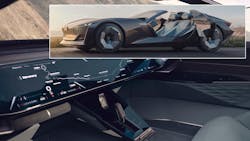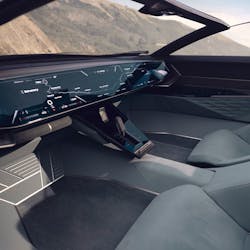Level 4 Autonomous Concept Cars Feature Variable Wheelbases
What you'll learn:
- What is a variable wheelbase?
- The design details that came together to create the skysphere concept car.
- How the Level 4 autonomous vehicle transforms into driver-operated mode.
Skysphere is the first of three upcoming concept cars from Audi. It will be followed by the grandsphere in 2021 and urbansphere in 2022. The Audi skysphere concept made its public debut on August 13, 2021, as part of Monterey Car Week, on the fairways of the Pebble Beach golf course.
All three concept cars are designed for Level 4 autonomous driving, meaning that in certain defined road and traffic situations, the driver can delegate complete responsibility to the car and no longer must intervene. Level 4 vehicles can operate in self-driving mode and monitor the driving environment, and will intervene if there’s a system failure. But while it doesn’t require human interaction in most circumstances (the human need not pay attention), there’s still the option to manually override in Level 4.
The Variable Wheelbase
The concept car was designed for two different driving experiences by making use of an unusual technical detail—a variable wheelbase. Electric motors and a sophisticated mechanism with body and frame components that slide into one another make it possible to vary the wheelbase itself and the exterior length of the car by 250 mm. At the same time, the vehicle’s ground clearance also can be adjusted.
The greater distance between wheels in its autonomous “Grand Touring” driving mode makes for a more comfortable ride with the steering wheel and the pedals retracting to provide more spacious seating. In this mode, the Audi skysphere automatically keeps an eye on the road and traffic with its sensor system while driving the occupants safely to their destination.
As the wheelbase changes, overall length changes from 194.5 inches to 204.3 inches. The skysphere’s ride height also can go up or down just under 0.4 in. to alter its performance and handling. Rear-wheel steering ensures that the vehicle remains agile despite its changing dimensions, according to Audi.
Powering the Electric Skysphere
The skysphere is powered completely by electricity. A single electric motor powers the rear wheels, turning out 624 hp (465 kW of power) and 553 lb-ft of torque (750 Newton-meters), which is quite a bit for a car that weighs just 3968 lb. (around 1,800 kg). As a result, the car can accelerate to 62 mph in a brisk four seconds.
The Audi skysphere’s battery modules are primarily positioned behind the cabin, a position well-suited for the vehicle’s center of gravity and agility. Further modules can be found between the seats in the center tunnel of the skysphere interior—another position chosen in favor of vehicle dynamics. The 80-kWh battery offers a range of more than 500 km (311 miles on the WLTP test cycle used in Europe). Mileage in the U.S. will likely be lower.
The Design Concept Behind the Concept Car
The Audi skysphere was designed in three months and built in two, using 3D digital technology. The concept car was conceived and designed at the Audi Design Studio in Malibu, Calif., close to the Pacific Coast Highway, the legendary coastal road that connects the suburbs of Los Angeles with northern California. Studio manager Gael Buzyn and his team are the creative minds behind the project. A legendary classic model from the company’s own history—the Horch 853 roadster—served as the inspiration for the new model.
A look under the hood of the Horch reveals a straight-eight engine with a displacement of 5 liters. The Audi skysphere, on the other hand, mainly has electric drive components between the front axle and the windshield, such as the charger and the dc-dc converter, plus the actuators and electronic and mechanical components for the adaptive wheelbase. It also features a spacious trunk filled with two golf bags specially designed for the concept car.
When it comes to their footprint the concept car pays its respects to the classic Horch model: 5.23 meters in length versus 5.19; 1.85-meter width versus 2.00 meters. Thus, it’s easy to see the similarity between the legendary Horch 853 convertible and the Audi skysphere.
A striking difference, on the other hand, can be found in their respective height: the Horch towered up to 1.77 meters, while its autonomous descendant, the Audi skysphere, ducks down to the road in Sport mode at 1.23 meters flat, with an optimized center of gravity and aerodynamics.
The new vehicle features double wishbone axles in the front and the rear. The upper and lower wishbones are forged or cast from aluminum. Steering takes place via a steer-by-wire system that controls both the front and the rear wheels.
Because the system isn’t mechanically connected to the front axle, the driver can select different steering ratios and steering settings, again at the touch of a button. This allows the steering to be adjusted from extremely direct to comfortable, but also from high to minimal self-aligning forces; for example, when parking. The rear-axle steering and adaptive wheelbase also contribute to the car’s relatively small turning radius.
Aerodynamics
The latest evolutionary stage of Audi’s adaptive air suspension, which is implemented in the concept car, features three independent air chambers to provide a comfortable base suspension. Individual chambers can be deactivated for a more sporty ride with fast acceleration. The result is that the characteristic curve of the springs becomes more progressive, reducing roll and pitch to a minimum. Lowering the body by 10 mm reduces aerodynamic drag, particularly relevant when driving long distances.
When simply coasting along, the individual wheels are selectively raised or lowered to compensate for unevenness and undulations in the road surface. This is the result of a symbiosis between the navigation system’s digital predictions and the active chassis’ control and actuation systems. Mounted on 23-in. alloy rims, the 285/30 tires strike a balance between suitability for long-distance trips thanks to minimal rolling resistance and a sporty, active driving style.
When the wheelbase is changed, the LEDs in the front and rear display a specially composed dynamic sequence. The rear end is dominated by a digitally controlled LED surface that extends across the entire width of the vehicle. Red LEDs are scattered across the vertical rear surface. Reflections create dynamic lighting and shadow effects when the lighting units are switched on and off.
The rocker panel is attached to the front end of the car, and as it moves, the panel also slides to the rear under the fixed door. In the process, the wheelbase is reduced from the size of the Audi A8L to the significantly more compact size of the Audi RS5.
As a result, control elements like the steering wheel and pedals can be swiveled into an invisible position and thereby completely removed from the interior. Free of controls, the interior appears as a more spacious environment, inspired by its Art Deco design.
Transforming into Driver Mode
Should the Audi skysphere concept be used in driver-operated mode, the interior transforms into a driving machine’s cockpit. Together with the chassis and body, the instrument panel and the monitor panel on the center console also move to the rear. The driver finds all of the controls, including the steering wheel and pedals, in the position that best suits them.
Large touch monitor surfaces (1415 mm wide, 180 mm high) on the dashboard and in the upper area of the center console are used to operate the vehicle and infotainment systems. In Grand Touring mode, this can be used to display content from the internet, video conferences, or streamed movies. Small touch panels in the doors are used to operate the air conditioning.
Customized infotainment options are available, too, such as linking the on-board streaming service to music and video providers used at home. Audi also aims to provide personalized and exclusive options for users of its luxury cars in the future, such as concerts, cultural events, or even sporting events that will only be available upon special invitation.


